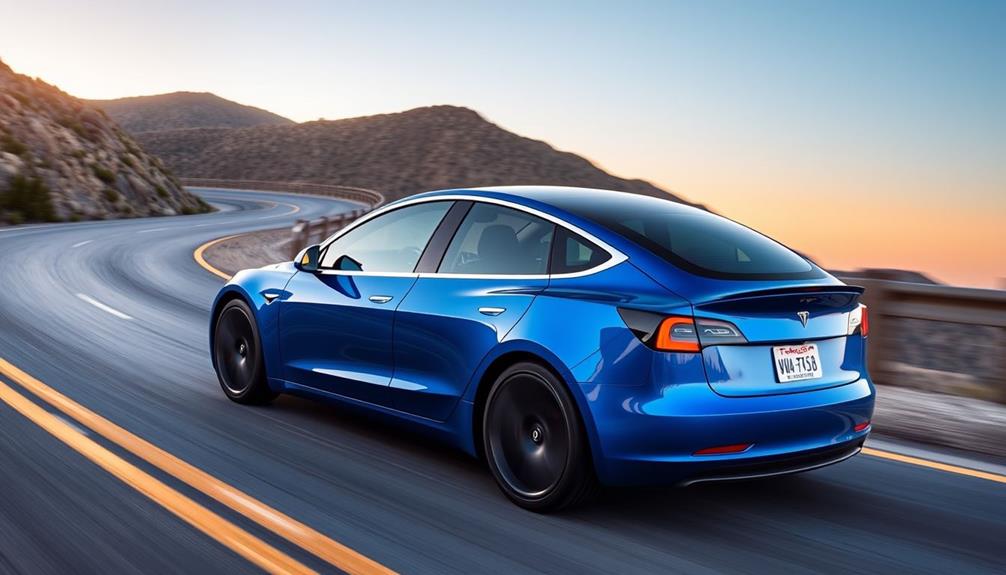You might be surprised to learn that Tesla vehicles have experienced 232 confirmed fire incidents. This statistic raises significant safety concerns around electric vehicles. While these fires often stem from battery malfunctions, including thermal runaway and accidents, it's worth noting that Tesla's fire rate is still lower than traditional gasoline cars. Nonetheless, 83 fatalities linked to these incidents underscore the seriousness of the issue. Tesla's commitment to safety includes advancements in fire-resistant technologies and regular updates to enhance vehicle performance. If you're curious about the specifics of these incidents and Tesla's safety measures, there's more to uncover.
Key Takeaways
- There have been 232 confirmed fire incidents involving Tesla vehicles to date.
- The majority of these fires are linked to battery malfunctions.
- 83 fatalities have been associated with Tesla fire incidents.
- Tesla experiences a fire rate of one fire per 130 million miles, which is lower than gasoline vehicles.
- Investigations and public scrutiny are increasing regarding the safety of electric vehicles like Tesla.
Overview of Tesla Fires
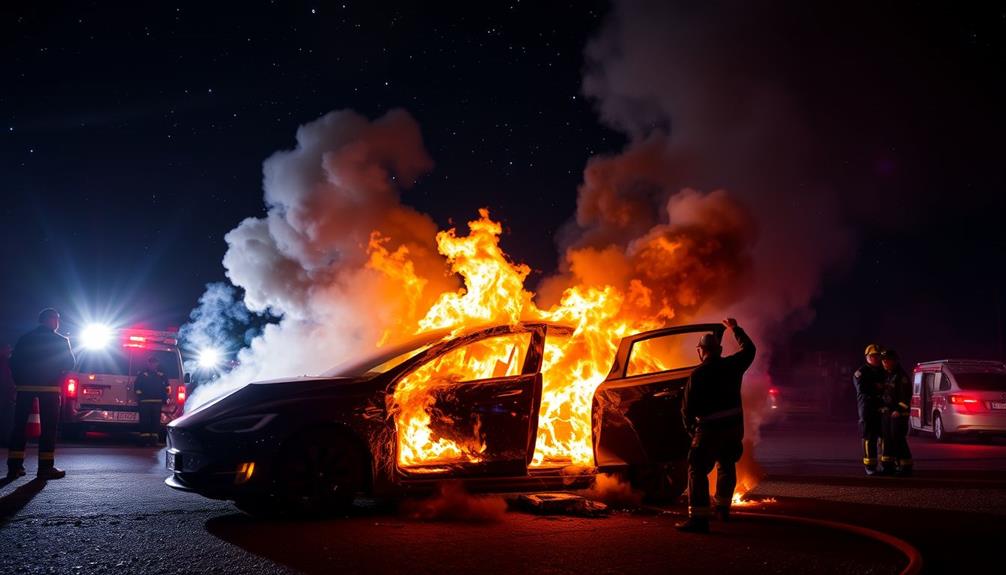
Tesla fire incidents have become a significant concern, with 232 confirmed cases reported to date. These incidents include a range of events involving Tesla vehicles, particularly the Model S, where thermal events have been documented.
You should know that the majority of these fires are linked to battery malfunctions, which can result in devastating outcomes. In fact, 83 fatalities have been associated with these fire incidents, underscoring the seriousness of the issue.
The National Fire Protection Association (NFPA) has raised alarms about the safety of electric vehicles like Tesla, prompting deeper investigations and data collection. The fire incidents you've heard about often arise from collisions or even spontaneous combustion, revealing unique risks tied to electric vehicle technology.
Additionally, the scope of fire risks extends beyond cars, affecting products such as Tesla's MegaPacks.
Ongoing monitoring of these thermal events is vital for safety assessments. Understanding the factors contributing to Tesla fires can help you make informed decisions about electric vehicle safety and awareness.
With the rise in electric vehicle adoption, it's important to stay informed about potential fire risks associated with brands like Tesla.
Recent Notable Incidents
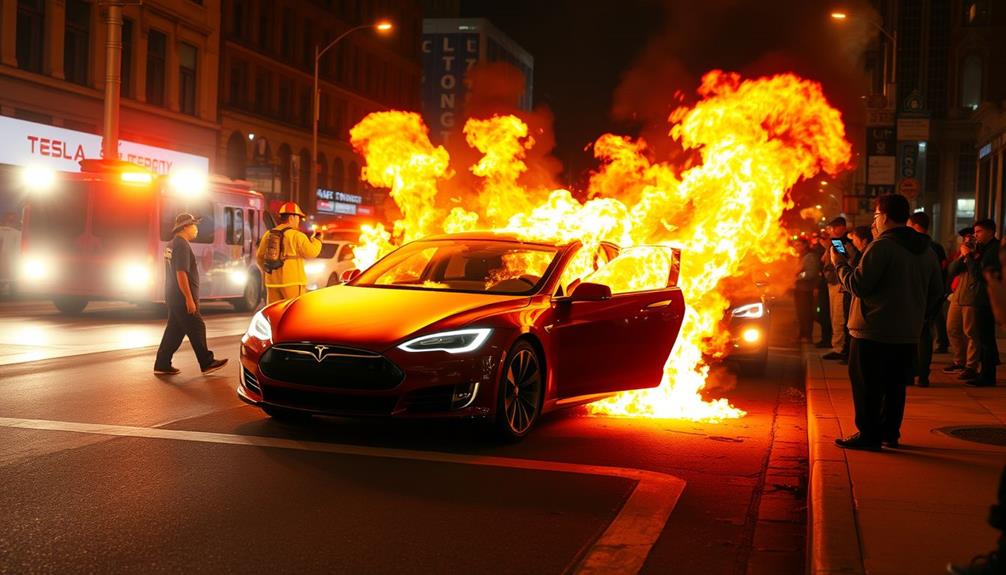
Recent notable incidents involving Tesla vehicles have raised significant safety concerns and captured public attention. These incidents highlight the ongoing debate about vehicle safety in electric vehicles. Here are a few recent events that stand out:
- On December 20, 2023, a Tesla crashed into a telephone pole and ignited in the USA.
- A Tesla caught fire while driving in the Netherlands on November 15, 2023, leading to worries about electric vehicle fires during operation.
- A DUI incident on March 5, 2023, resulted in a Tesla catching fire in Canada, showcasing the risks tied to impaired driving.
These incidents underscore the importance of fire safety and the need for ongoing vigilance regarding Tesla fires.
A head-on collision on February 20, 2023, in the USA also resulted in a fire, emphasizing the dangers of high-speed impacts.
Additionally, an alarming situation occurred on January 7, 2023, when a Tesla erupted into flames at a service station in South Korea, raising questions about fire safety near fueling locations.
Each of these events reminds us of the critical nature of vehicle safety and the potential risks that come with electric vehicles.
Causes of Tesla Fires
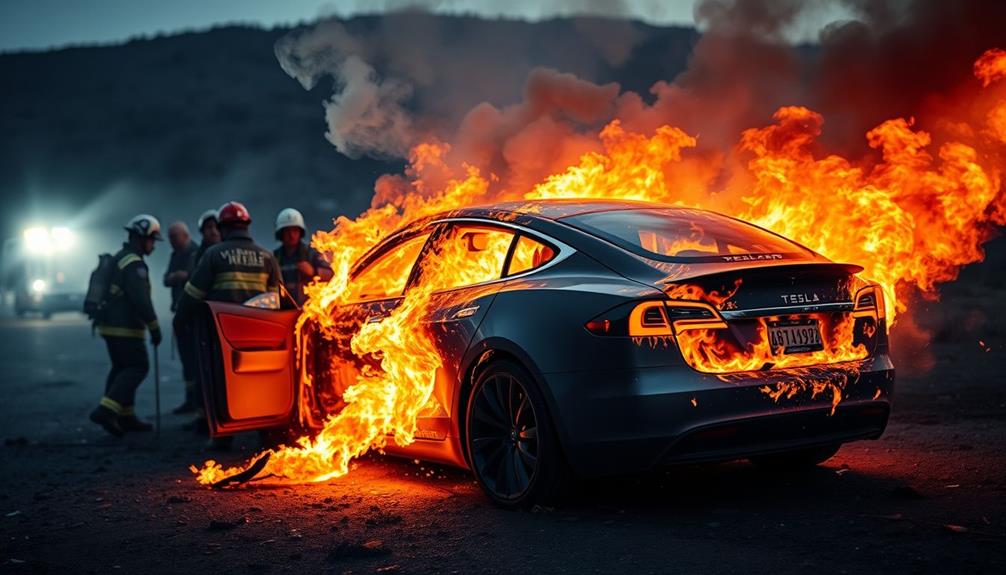
Understanding the causes of Tesla fires is vital for improving vehicle safety. One of the most common triggers is collisions with stationary objects, like trees and poles. Significant impact damage often leads to battery damage, increasing the risk of fire.
Furthermore, thermal runaway incidents can occur during battery operation or charging, contributing to the fire risk in these vehicles.
Spontaneous combustion is another serious concern; there have been documented cases where fires ignited while Teslas were parked or charging. Investigators frequently find that multiple factors contribute to these incidents, including vehicle malfunctions and external collision impacts.
When you're driving a Tesla, it's important to be aware of these potential risks. Understanding that battery damage from accidents can lead to Tesla fires helps you appreciate the significance of safe driving practices.
Additionally, recognizing the signs of thermal runaway can help you take action before a minor issue escalates. By staying informed about these causes, you can make safer choices and help enhance the overall safety of electric vehicles.
Safety Concerns and Comparisons
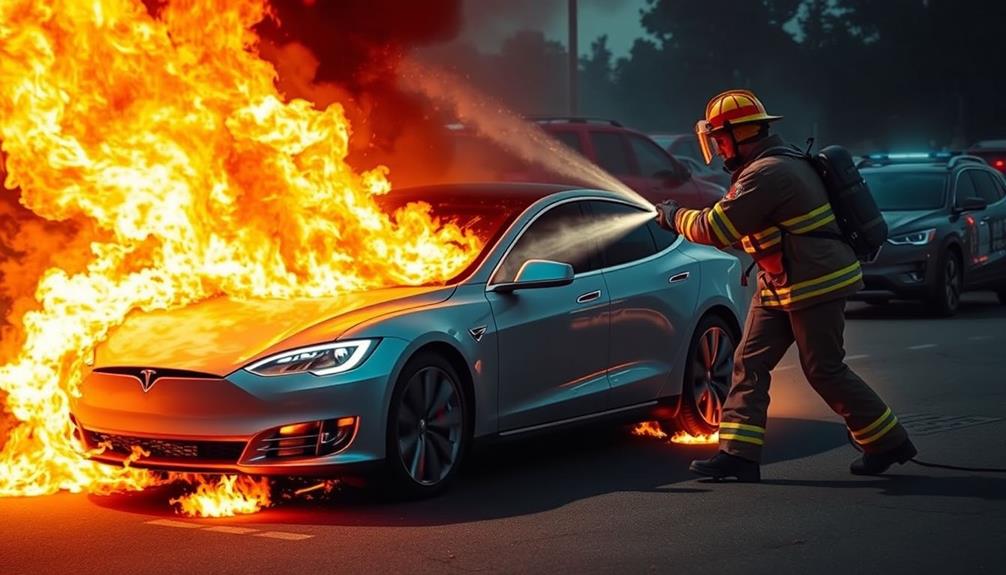
When it comes to safety concerns surrounding electric vehicles, comparisons between Teslas and traditional gasoline-powered cars reveal some surprising insights. While Tesla fires have made headlines, the statistics paint a more nuanced picture. Data shows that Teslas experience one fire per 130 million miles traveled, a stark contrast to the average rate of one vehicle fire per 18 million miles in the U.S. overall.
Here are some key points to take into account:
- Tesla's fire rates are lower than gasoline-powered vehicles, which face one fire per 1,350 cars.
- Despite fewer incidents, there have been 83 fatalities linked to 232 confirmed Tesla fire incidents.
- The Insurance Institute for Highway Safety (IIHS) indicates that Tesla vehicles have higher claim frequencies for fire incidents compared to traditional internal combustion engine vehicles.
Public interest in the safety of electric cars is rising, spurred by the National Fire Protection Association's calls for enhanced regulatory scrutiny.
While it's essential to address these safety concerns, it's equally important to recognize that Teslas, overall, have a lower incident rate of car fires compared to their gasoline counterparts.
Prevention and Safety Measures
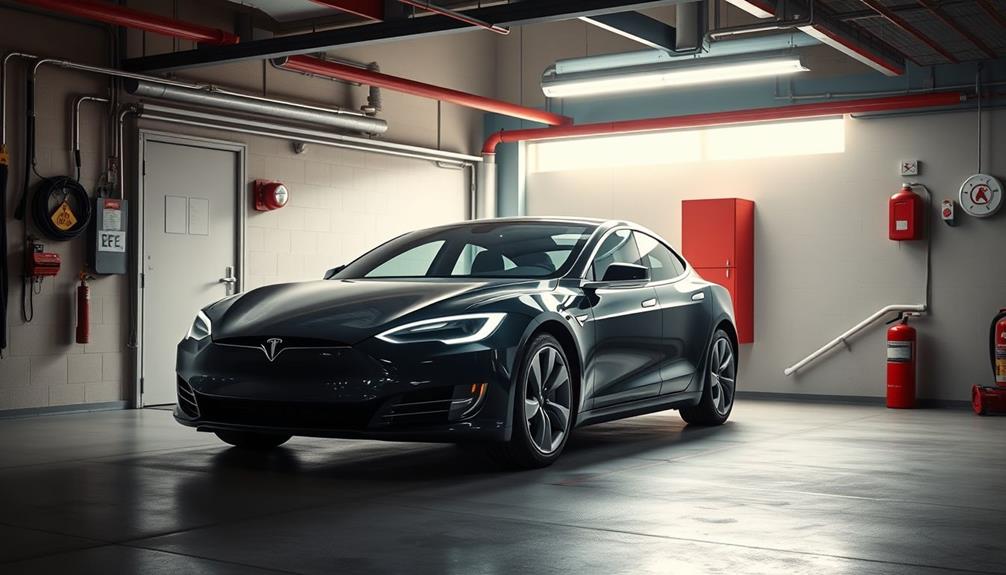
Effective prevention and safety measures are essential for minimizing fire risks in Tesla vehicles. By following these guidelines, you can help guarantee your electric vehicle remains safe and reduce the likelihood of fire incidents.
| Safety Measure | Description |
|---|---|
| Regular Maintenance | Conduct routine checks to identify potential fire risks. |
| Safe Charging Practices | Use certified chargers and avoid overloading circuits. |
| Immediate Incident Reporting | Report any fire incidents promptly for quicker responses. |
Incorporating these safety measures can greatly impact fire prevention. Regular maintenance helps you spot issues before they escalate. Adopting safe charging practices, like using approved equipment, minimizes hazards during charging. If you ever experience a fire incident, report it immediately to authorities; this can lead to timely interventions and improved safety protocols.
Moreover, Tesla’s commitment to ongoing research and development in fire-resistant technologies, such as advanced battery designs, further enhances overall safety. Their over-the-air updates guarantee that your vehicle’s safety features improve continuously based on real-world data, making it easier for you to stay ahead of potential fire risks. Furthermore, Tesla’s dedication to safety is evident in the implementation of sentry mode features, which provide added protection for your vehicle when it is parked. These features use the vehicle’s external cameras to monitor the surroundings and can alert the owner if any suspicious activity is detected. This added layer of security not only protects against fire risks but also enhances the overall safety and security of the vehicle. With these ongoing advancements and safety features, Tesla continues to prioritize the well-being of its customers and their vehicles.
Tesla's Response to Fires
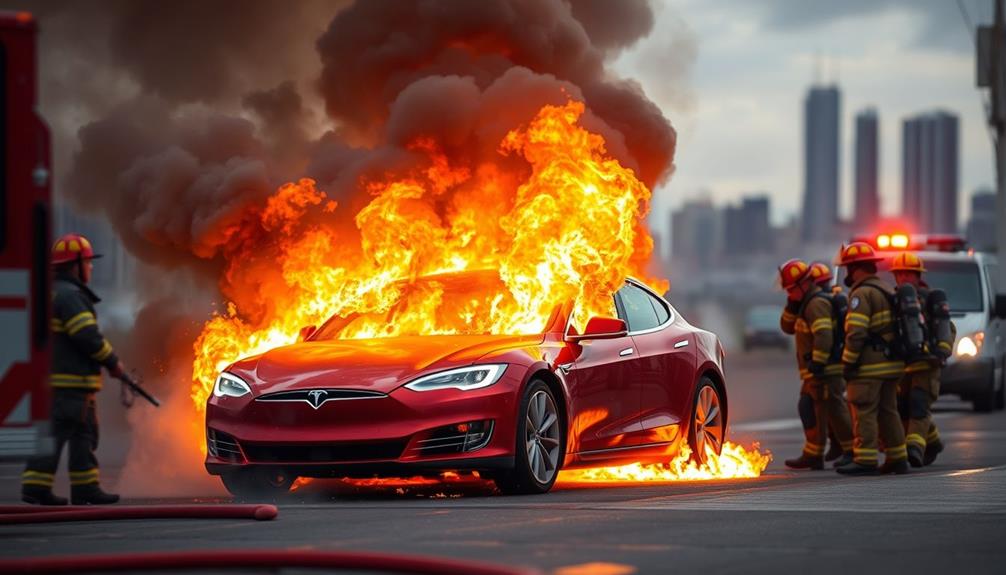
Following robust prevention and safety measures, Tesla is proactive in addressing fire incidents when they occur. The company focuses on enhancing safety for its Model S vehicles, implementing a software update that increases ride height at highway speeds. This aims to minimize underbody impact damage, which could potentially lead to fires.
Here's how Tesla responds effectively:
- Warranty Coverage: Tesla offers warranty coverage for fire damage to Model S vehicles, including incidents caused by driver error, while excluding deliberate destruction claims.
- NHTSA Involvement: In response to safety concerns, Tesla requested an investigation from the National Highway Traffic Safety Administration (NHTSA) to confirm vehicle safety.
- Open Communication: Tesla maintains an open communication strategy to address fire incidents, helping to uphold credibility while being cautious about overstating safety claims.
Statistics show that fires in Model S vehicles occur at approximately one per 6,333 units, which is considerably lower than gasoline vehicles, where the rate is one per 1,350.
Future Implications for Tesla

The ongoing NHTSA investigation into Tesla fire incidents could profoundly shape the future of the company. If the investigation results in mandatory safety improvements across the Model S fleet, you might see significant shifts in Tesla's design and manufacturing practices.
This could lead to costly retrofitting solutions aimed at enhancing fire safety, potentially resulting in financial repercussions that could impact profitability.
Moreover, the investigation's findings may alter market perception of Tesla. If the results contradict bold claims about vehicle safety, it could challenge the credibility of both the company and its leadership.
This shift could influence consumer confidence, making potential buyers hesitant and affecting overall sales.
Additionally, expect fluctuations in Tesla's stock value as public and investor reactions to the safety issues unfold. As the investigation progresses, the implications for Tesla could extend beyond just fire safety measures; they might reshape how consumers view the brand.
Ultimately, how effectively Tesla navigates this investigation will determine its future standing in the electric vehicle market and its ongoing commitment to safety and innovation.
Frequently Asked Questions
Are Tesla Fires Rare?
Yes, Tesla fires are rare. When you compare their occurrence to traditional vehicles, you'll find Teslas catch fire less frequently. The data shows a markedly lower rate, making them safer in this regard.
Why Are Tesla Fires Hard to Put Out?
When it comes to extinguishing Tesla fires, you're facing a fierce dragon. High-energy lithium-ion batteries release flames that can reignite, making it tough for firefighters without specialized training or equipment to tackle these blazing challenges.
How Many Tesla's Are Involved in Accidents?
You'd find that Tesla's accident rates are impressively low with Autopilot engaged, recording one crash for every 6.88 million miles driven. This indicates that using the technology enhances safety compared to traditional driving methods.
Have Tesla Powerwalls Ever Caught Fire?
Have you ever wondered about the safety of your Tesla Powerwall? While there've been rare incidents of fires, they're usually due to external issues. Tesla's safety features greatly reduce risks, keeping your home secure.
Conclusion
To sum up, while Tesla fire incidents can seem alarming, it's crucial to remember that these events are relatively rare compared to traditional vehicles. With ongoing advancements in technology and safety measures, Tesla is committed to improving the safety of its cars. As they continue to innovate—much like a knight in shining armor—drivers can feel more secure on the road. Staying informed and vigilant is key, so you can enjoy the ride without unnecessary worry.




